Federal University Of Rio De Janeiro
-
- UFRJ Wins Student Design Competition Maritime Reporter, Oct 2002 #35
A team from the Naval and Ocean Engineering Department at the Federal University of Rio de Janeiro (UFRJ) has won the first International Student Offshore Design Competition sponsored by the Society of Naval Architects and Marine Engineers (SNAME) and the Ocean, Offshore and Arctic Engineering Division of the American Society of Mechanical Engineers (ASME) with their entry "Preliminary Design of the 'Maracana' FPSO Unit." The entry was one of eight projects submitted by students from universities around the world.
The UFRJ team was honored with a cash prize of $1,500 and the opportunity to present the Maracana floating production/storage and offloading unit (FPSO) to industry at the SNAME Annual Meeting in Boston on September 25-28.
Alexandre Alho, Assistant Professor, UFRJ and Advisor to the six person award-winning design team, said that in order to simulate an actual commercial project, the team was divided into six main categories: structure, stability, marine engineering, sea keeping and costs with a team leader or project manager.
"The biggest challenge for us was this was not a conversion of an existing ship but an FPSO design from the beginning," said Joao Alberto Rangel de Almeida, Team Leader.
The students used research and data from Petrobras to base their design model on a site- specific structure located offshore Brazil in the Campos Basin.
Design team students worked as interns for the independent Brazilian offshore and ship design company Projemar during the competition The award winning "Maracana" FPSO features a symmetrical ship form measuring 886 x 157 x 98 ft.
(270 x 48 x 30 m) and a load capacity of 1.5 million barrels.
The UFRJ team members are: Rodrigo Klim Gomes, Eleandro Meira de Oliveira, Joao Alberto Rangel de Almeida, Antonio Goncalves de Vasconcelos Neto, Maiza Pimenta Goular and Cassiano Rodrigues Neves.
With Maritime Reporter & Engineering News serving as ISODC's official publication, the corporate sponsors for the competition were ABS (American Bureau of Shipping), Conoco and Projemar.
-
- Reviewing Sapinhoá-Lula NE BSR System Marine Technology, Sep 2018 #18
a large number of wells to a single FPSO was developed by the Petrobras’ research center (Cenpes) and Subsea 7, with the support of UFRJ (Federal University of Rio de Janeiro) and USP (University of São Paulo). The project required the installation of four huge 2,800ton submerged buoys approximately 250 meters
-
- UFRJ Nautilus: A Brazilian AUV Project Marine Technology, Sep 2018 #38
participate in the annual Robosub competition. According to project founder, Lucas Armand, a Naval and Ocean Engineering graduate from the Federal University of Rio de Janeiro (UFRJ), the emergence of Nautilus has a lot to do with personal history: “I was having a difficult time in college, because I no longer
-
- Brazil Class Maritime Reporter, Jul 2013 #30
are working closely with companies involved to maximize this potential.” ABS is also working with Petrobras’ R&D center CENPES, COPPE/UFRJ (Federal University of Rio de Janeiro) and other organizations on R&D efforts, local content certification, FPSO life extension (FLEx) and more. Buoyed by Brazil’s development
-
- Cenpes Leading Petrobras’ R&D Effort Marine Technology, Apr 2013 #32
hemisphere, located about 10km from downtown Rio de Janeiro at Fundão Island, which is part of a technological complex administered by the Federal University of Rio de Janeiro (UFRJ). Both the old Cenpes center and the new building are located within what is known as the UFRJ Technology Park (or Rio Technology
-
- Brazil Offshore: Petrobras & Subsea Engineering Marine Technology, Nov 2013 #34
of Petrobras’ DNA and by working in cooperation with institutions such as the ANP (National Petroleum Regulator), universities such as the Federal University of Rio de Janeiro (UFRJ) and service companies like FMC Technologies, Subsea 7 and DeepOcean, Petrobras has found solutions to many problems and challenges
-
- OSX: Full Speed Ahead on Mammoth Shipyard Project Maritime Reporter, Feb 2013 #30
. m.,” said Baptista Danilo Souza Baptista OSX, Shipyard Operations Officer Baptista has a degree in Mechanical Engineering from the Federal University of Rio de Janeiro and has a specialization degree in Equipment and Maintenance Engineering and Managerial development by the University of São Paulo.
-
 )
March 2024 - Marine Technology Reporter page: 48
)
March 2024 - Marine Technology Reporter page: 48Index page MTR MarApr2024:MTR Layouts 4/4/2024 3:19 PM Page 1 Advertiser Index PageCompany Website Phone# 17 . . . . .Airmar Technology Corporation . . . . . . . . . .www.airmar.com . . . . . . . . . . . . . . . . . . . . . . . . . . . . . . . . .(603) 673-9570 9 . . . . . .Birns, Inc. . . . . . . . . . .
-
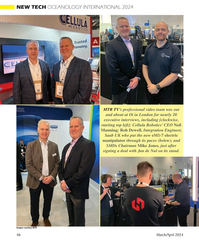 )
March 2024 - Marine Technology Reporter page: 46
)
March 2024 - Marine Technology Reporter page: 46NEW TECH OCEANOLOGY INTERNATIONAL 2024 MTR TV’s professional video team was out and about at Oi in London for nearly 20 executive interviews, including [clockwise, starting top left]: Cellula Robotics’ CEO Neil Manning; Rob Dewell, Integration Engineer, Saab UK who put the new eM1-7 electric manipulator
-
 )
March 2024 - Marine Technology Reporter page: 45
)
March 2024 - Marine Technology Reporter page: 45ronments. The new agreement will address speci? c techni- cal gaps in the UUV defense and offshore energy markets especially for long duration, multi-payload mission opera- tions where communications are often denied or restricted. As part of the new alliance, Metron’s Resilient Mission Autonomy portfolio
-
 )
March 2024 - Marine Technology Reporter page: 39
)
March 2024 - Marine Technology Reporter page: 39Photo courtesy Global Ocean Design Figure 7 A 35Ah AGM lead-acid battery is tested using the West Mountain Radio CBA to show the effect of simply ? lling the battery voids with mineral oil as a compensating ? uid. The CBA is programmed to cut-off at a voltage of 10.50v. The top line (red) shows the
-
 )
March 2024 - Marine Technology Reporter page: 36
)
March 2024 - Marine Technology Reporter page: 36LANDER LAB #10 Of special interest for marine applications, LiPo batteries are Shipping any kind of lithium battery can be a challenge, and offered in a “pouch” design, with a soft, ? at body. The pouch IATA regs vary with the batteries inside or outside an instru- is vacuum-sealed, with all voids ?
-
 )
March 2024 - Marine Technology Reporter page: 33
)
March 2024 - Marine Technology Reporter page: 33regulated industry in the world.” How- ever, commercial success depends on many factors, not least a predictable OPEX. Over the past four years, SMD has worked with Oil States Industries to calculate cost per tonne ? gures for prospective customers. Patania II uses jet water pumps to Oil States’
-
 )
March 2024 - Marine Technology Reporter page: 32
)
March 2024 - Marine Technology Reporter page: 32FEATURE SEABED MINING by a sea? oor plume from its pilot collection system test. pact, nodule collection system that utilizes mechanical and The Metals Company recently signed a binding MoU with hydraulic technology. Paci? c Metals Corporation of Japan for a feasibility study on The company’s SMD
-
 )
March 2024 - Marine Technology Reporter page: 27
)
March 2024 - Marine Technology Reporter page: 27SEA-KIT USV Maxlimer returning from HT-HH caldera in Tonga. © SEA-KIT International data and further assess ecosystem recov- ery. What is known, noted Caplan-Auer- bach, is that the impact of submarine vol- canoes on humans is rare. “The HT-HH eruption was a tragedy, but it was very unusual. It let us
-
 )
March 2024 - Marine Technology Reporter page: 23
)
March 2024 - Marine Technology Reporter page: 23elatively inactive since 2014, the Hunga Tonga–Hunga Ha‘apai (HT-HH) submarine volcano began erupting on December 20, 2021, reaching peak intensity on January 15, 2022. This triggered tsunamis throughout the Pa- R ci? c, destroyed lives and infrastructure, and generated the largest explosion recorded
-
 )
March 2024 - Marine Technology Reporter page: 15
)
March 2024 - Marine Technology Reporter page: 15sensor options for longer mission periods. About the Author For glider users working in ? sheries and conservation, Shea Quinn is the Product Line Manager the Sentinel can run several high-energy passive and active of the Slocum Glider at Teledyne Webb acoustic sensors, on-board processing, and imaging
-
 )
March 2024 - Marine Technology Reporter page: 11
)
March 2024 - Marine Technology Reporter page: 11assist in identifying mines and act as a neutralization device. About the Author Bottom mines pose even greater chal- David R. Strachan is a defense analyst and founder of lenges. Unlike contact mines, bottom Strikepod Systems, a research and strategic advisory mines utilize a range of sensors to
-
 )
March 2024 - Marine Technology Reporter page: 6
)
March 2024 - Marine Technology Reporter page: 6MTR Editorial Advisors Gallaudet Hardy The Honorable Tim Gallaudet, Kevin Hardy is President PhD, Rear Admiral, U.S. of Global Ocean Design, Navy (ret) is the CEO of creating components and Ocean STL Consulting and subsystems for unmanned host of The American Blue vehicles, following a career
-
 )
April 2024 - Maritime Reporter and Engineering News page: 35
)
April 2024 - Maritime Reporter and Engineering News page: 35SIMULATION e have a close relationship with tech- Realism is prized beyond immersive, photo-realistic visu- nology, evidenced by, for example, als, and providers are introducing increasingly accurate func- the phones we are estimated to un- tionality. FORCE Technology’s upcoming DEN-Mark2 math- lock around
-
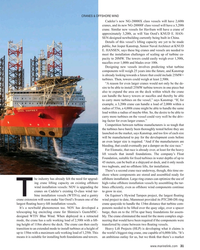 )
April 2024 - Maritime Reporter and Engineering News page: 31
)
April 2024 - Maritime Reporter and Engineering News page: 31CRANES & OFFSHORE WIND Cadeler’s new NG-20000X class vessels will have 2,600t cranes, and its new NG-20000F class vessel will have a 3,200t crane. Similar new vessels for Havfram will have a crane of approximately 3,200t, as will Van Oord’s KNUD E. HAN- SEN-designed newbuilding currently being built in
-
 )
April 2024 - Maritime Reporter and Engineering News page: 21
)
April 2024 - Maritime Reporter and Engineering News page: 21ROB LANGFORD, VP, GLOBAL OFFSHORE WIND ob Langford has worked in the offshore industry ABS. “We are growing and evolving our services across all for more than three decades, ‘cutting his teeth’ offshore infrastructure along with our continued support to the in a UK design ? rm working in the North Sea
-
 )
April 2024 - Maritime Reporter and Engineering News page: 14
)
April 2024 - Maritime Reporter and Engineering News page: 14Book Review Approach to Meeting Underwater Radiated Noise Limits Def ned By Raymond Fischer uantitative underwater radiated noise limits will construction inspections, 5) possible training with respect to be developed shortly by IMO, and/or countries salient design/construction essentials, 6) compliance
-
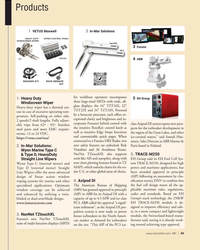 )
April 2024 - Marine News page: 43
)
April 2024 - Marine News page: 43Products 1 2 VETUS Maxwell In-Mar Solutions 3 Furuno ABB 4 for workboat operators encompasses EH Group 1. Heavy Duty 5 three large-sized MFDs with wide, all- Windscreen Wiper glass displays: the 16” TZT16X, 22” Heavy-duty wiper has a thermal cut- TZT22X and 24” TZT24X. Powered out in
-
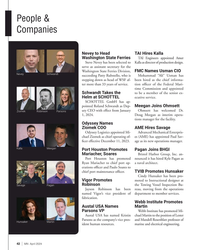 )
April 2024 - Marine News page: 42
)
April 2024 - Marine News page: 42is Mohammad “Ali” Usman has stepping down as head of WSF af- been hired as the chief informa- ter more than 33 years of service. tion of? cer of the Federal Mari- time Commission and appointed Schwandt Takes the to be a member of the senior ex- Helm at SCHOTTEL ecutive service. SCHOTTEL GmbH has ap- pointed
-
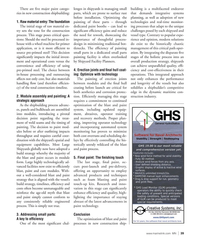 )
April 2024 - Marine News page: 39
)
April 2024 - Marine News page: 39There are ? ve major paint catego- lenges in shipyards is managing small building is a multifaceted endeavor ries in new construction shipbuilding: parts, which are prone to surface rust that demands integrative systems before installation. Optimizing the planning, as well as adoption of new 1.
-
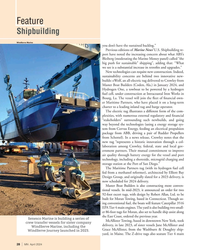 )
April 2024 - Marine News page: 28
)
April 2024 - Marine News page: 28Propellers from Schottel). In a news release, Crowley notes that the new tug “represents a historic innovation through a col- laboration among Crowley, federal, state and local gov- ernment partners. Their mutual commitment to improve air quality through battery energy for the vessel and port technology
-
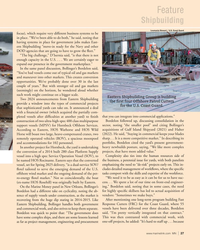 )
April 2024 - Marine News page: 27
)
April 2024 - Marine News page: 27Feature Shipbuilding Loumania Stewart / U.S. Coast Guard focus), which require very different business systems to be in place. “We’ve been able to do both,” he said, noting that having systems in place for government jobs makes East- ern Shipbuilding “move-in ready for the Navy and other DOD agencies
-
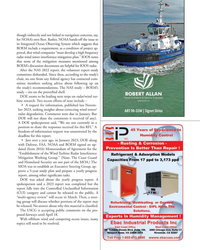 )
April 2024 - Marine News page: 25
)
April 2024 - Marine News page: 25for IOOS radar. After the NAS 2022 report, the volunteer expert study committee disbanded. Since then, according to the study’s chair, no one from any federal agency has contacted com- mittee members seeking advice about following up on the study’s recommendations. The NAS study – BOEM’s study – sits on
-
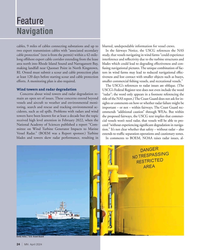 )
April 2024 - Marine News page: 24
)
April 2024 - Marine News page: 24commercial ? shing vessels, and recreational vessels.” The USCG’s references to radar issues are oblique. (The Wind towers and radar degradation USCG’s Federal Register text does not even include the word Concerns about wind towers and radar degradation re- “radar”; the word only appears in a footnote referencing
-
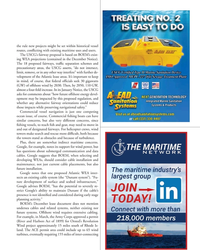 )
April 2024 - Marine News page: 23
)
April 2024 - Marine News page: 23, limit, remove, or in any other way interfere” with further de- velopment of the Atlantic lease areas. It’s important to keep in mind, of course, that federal of? cials seek 30 gigawatts (GW) of offshore wind by 2030. Then, by 2050, 110 GW, almost a four-fold increase. In its January Notice, the USCG
